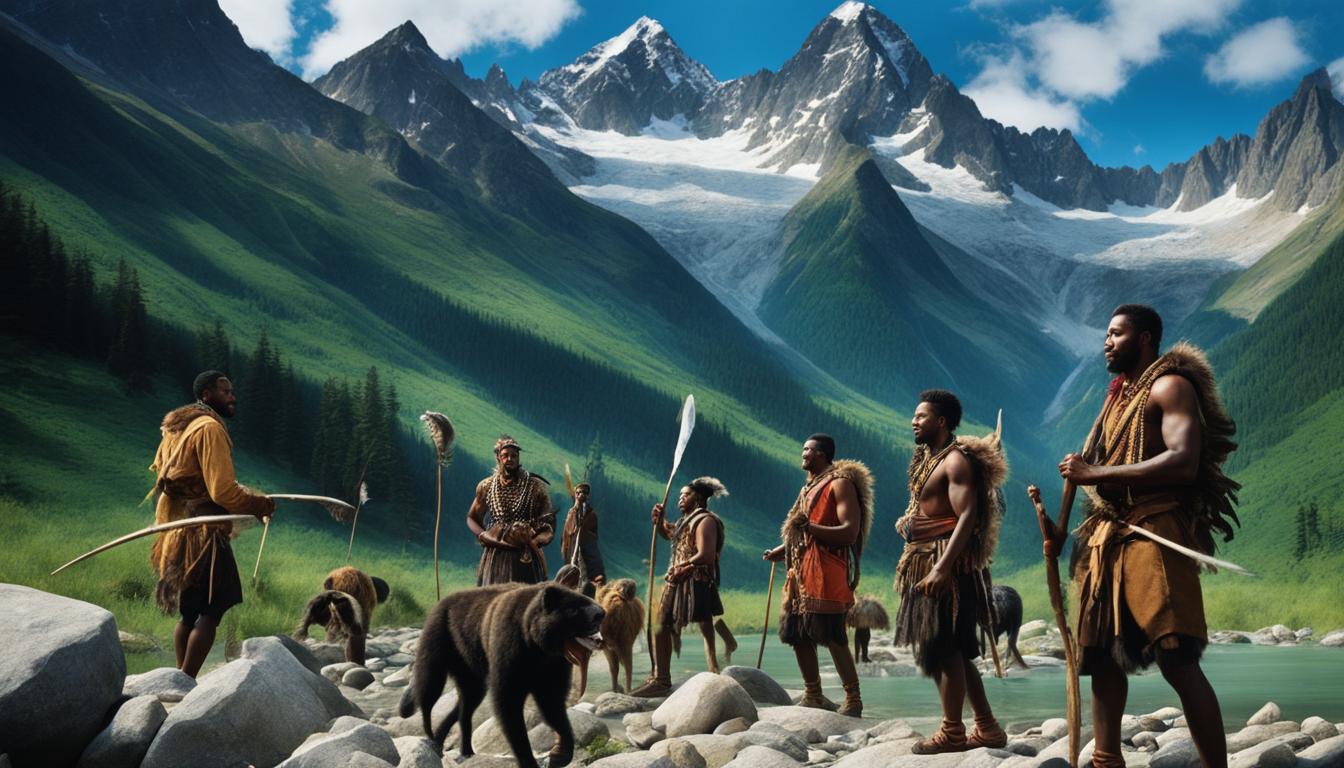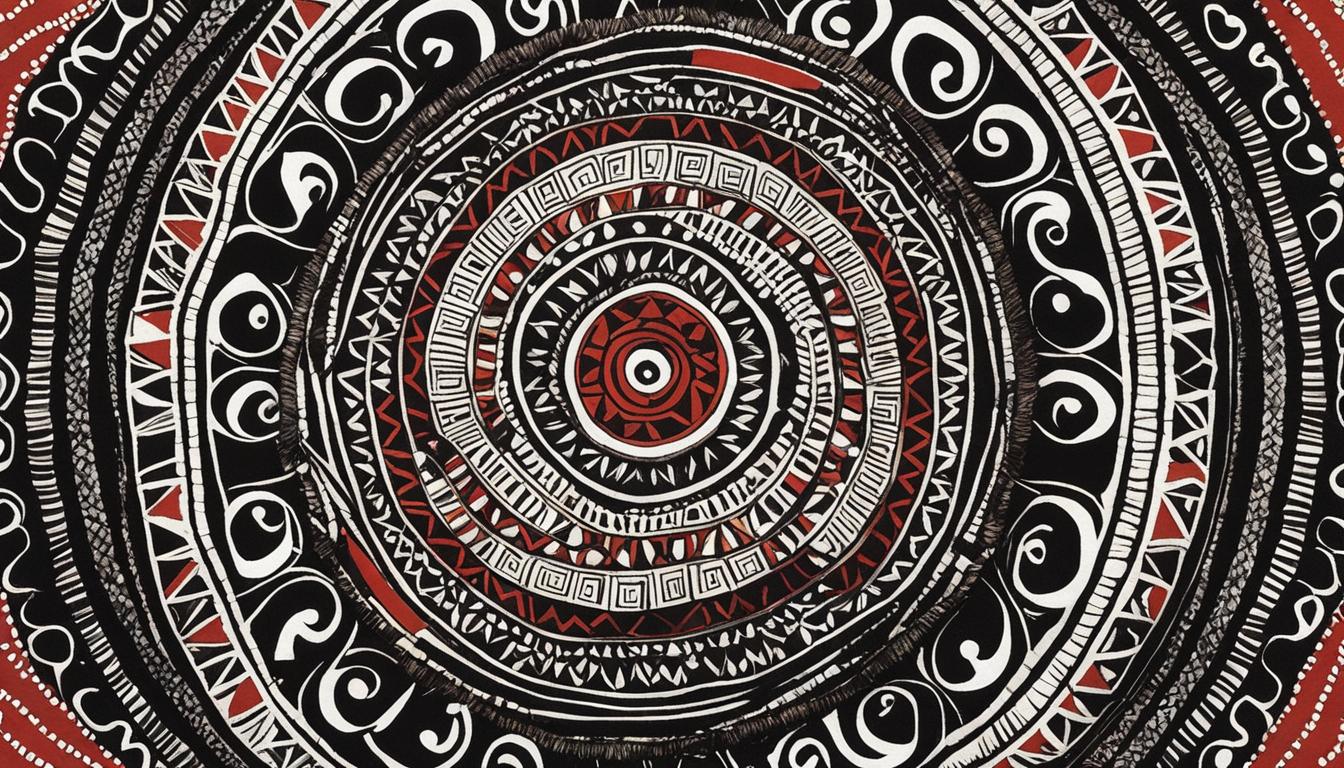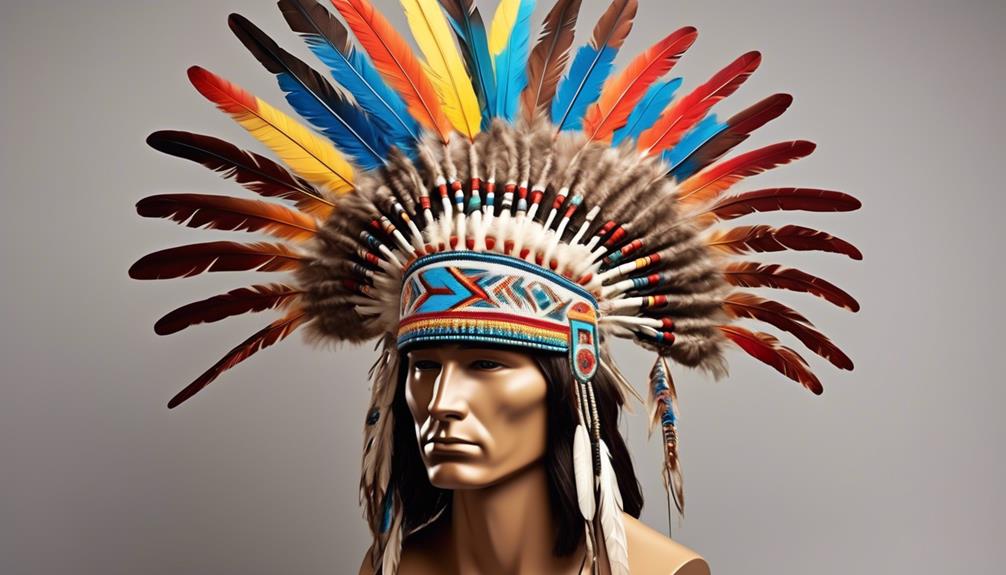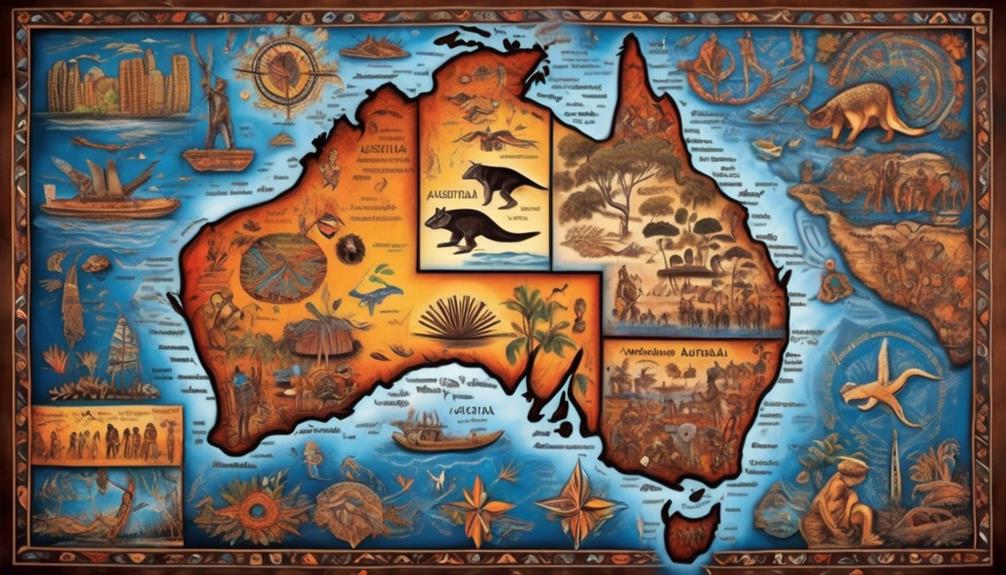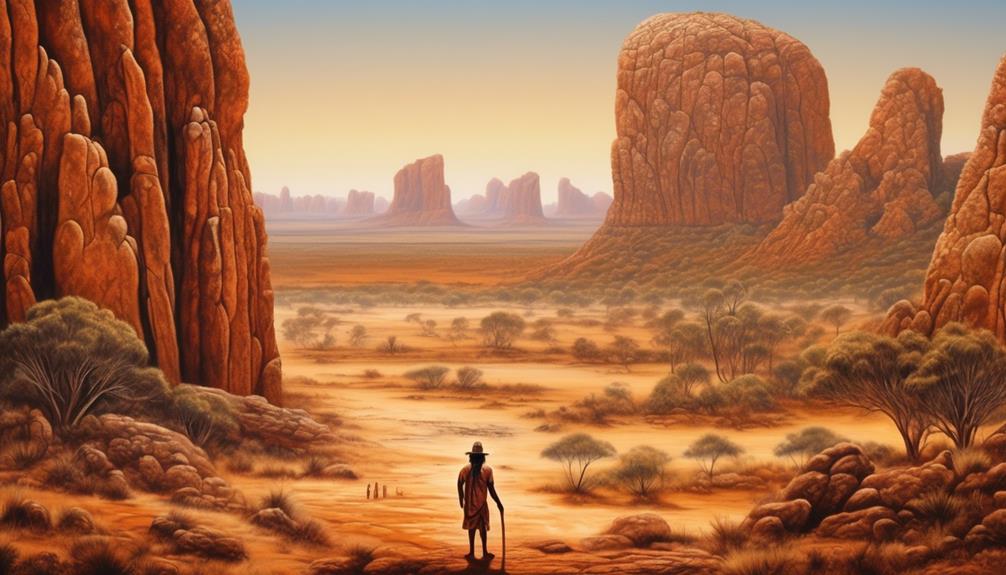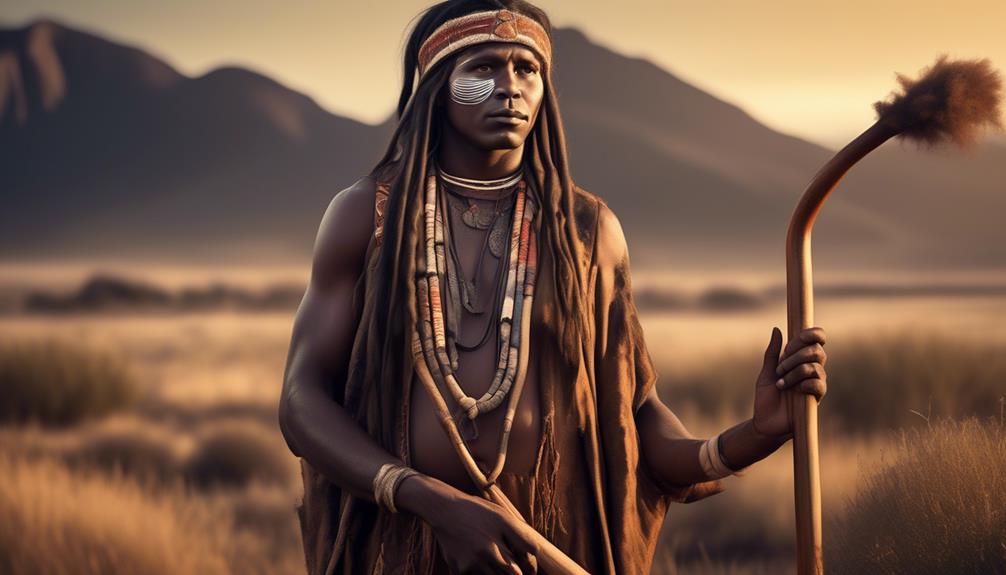Through our exploration of Australian history, a frequently asked question arises about the first inhabitants of the land before the Aboriginal communities. While this topic has sparked many discussions and arguments, the prevailing consensus among researchers is that the Aboriginal people were the original settlers of Australia.
Claims of a pre-Aboriginal population based on skeletal remains and rock art have been largely discredited and are no longer widely debated. Whether it’s the analysis of ancient skeletons or the interpretation of rock art, the evidence strongly supports the idea that the Indigenous tribes in Australia were the earliest settlers in the region.
Key Takeaways:
- The Aboriginal people were the first inhabitants of Australia.
- Claims of a pre-Aboriginal population have been largely discredited.
- Anthropological evidence supports the idea that Indigenous tribes in Australia were the earliest settlers.
- Skeletal remains and rock art analyses contribute to our understanding of Australia’s prehistory.
- Recognizing the cultural heritage of Aboriginal people is essential for fostering understanding and respect.
The Evidence on Skeletons
Anthropologists have meticulously studied the skeletal remains discovered in Australia, offering valuable insights into the country’s ancient civilizations and early human presence. One notable set of remains is the 42,000-year-old skeleton of Mungo Man.
Although some have suggested that these remnants indicate the existence of a pre-Aboriginal population, subsequent research has discredited such claims. Most anthropologists do not widely accept these assertions. In fact, DNA analysis of the Mungo Man remains has shown that any deviations were likely due to contamination from the scientists handling the fossils.
The prevailing consensus among experts is that all known skeletal remains in Australia belong to a single source population. This aligns with the notion that Aboriginal people were the first to occupy the continent, further supporting the rich history and significance of indigenous tribes in Australia.
| Ancient Skeleton | Age | Examination Result |
|---|---|---|
| Mungo Man | 42,000 years | Contamination of DNA analysis, no evidence for pre-Aboriginal population |
| Other Skeletal Remains | Varying ages | Belong to one source population, supporting Aboriginal origins |
The Evidence on Rock Art
The Gwion Gwion rock art in the Kimberley region of Western Australia has sparked debates regarding its origin and the possibility of a non-Aboriginal population creating it. However, a careful analysis of the rock art has shown that the claims of non-Aboriginal authorship are not well-supported.
Similarities between the Gwion Gwion figures and rock art from Arnhem Land suggest that the painters of the earlier images were likely the ancestors of the Aboriginal people who painted the later images. This connection hints at a continuation of artistic expression and cultural traditions among Indigenous tribes in Australia.
When interpreting rock art, it is crucial to consider the historical context and potential biases that may have influenced our understanding. By examining the rock art within the broader framework of ancient cultures in Australia, we can gain valuable insights into the pre-Aboriginal history and indigenous tribes of the region.
This image displays a beautiful example of Gwion Gwion rock art, showcasing the intricate and expressive nature of this ancient form of artistic expression.
Migration Routes and Waves
The migration routes taken by the first people to settle in Australia are a topic of ongoing research and debate among experts. It is believed that these early inhabitants arrived on the continent by sea, potentially following island-hopping routes from Southeast Asia.
The exact timing and number of population migrations are still being studied, but genetic research suggests a complex history of migration and interaction between different population groups in Australia and neighboring regions. These findings shed light on the diverse origins and cultural connections of the prehistoric inhabitants of Australia.
The migration routes and waves of early settlers played a crucial role in shaping the indigenous people of Australia, their culture, and traditions. Exploring these migration patterns not only broadens our understanding of the first people of Australia but also highlights the rich and diverse tapestry of indigenous tribes across the continent.
Theories and Hypotheses
Researchers have developed several theories and hypotheses to explain the migration routes and waves of the early settlers in Australia. These include:
- The island-hopping hypothesis: This theory suggests that the first people to reach Australia used boats or rafts to navigate between islands in Southeast Asia before finally reaching the Australian continent.
- The coastal migration hypothesis: According to this theory, the early settlers followed the coastline of Southeast Asia and made their way to Australia by traveling along the shores.
- The accidental colonization theory: Some researchers propose that the first people arrived in Australia unintentionally, possibly due to natural events like tsunamis or storms that carried them across the sea.
While these theories provide possible explanations, further research is needed to establish definitive migration routes and understand the complexities of the early settlement in Australia.
Implications and Significance
“Understanding the migration routes and waves of the first people in Australia deepens our knowledge of prehistoric inhabitants and their contributions to the culture and heritage of the continent.”
By studying the migration patterns, we gain insights into the diverse origins and cultural connections of the indigenous people in Australia. The interactions between different population groups influenced the development of unique languages, traditions, and beliefs that shape the rich tapestry of indigenous cultures in Australia.
This ongoing research not only celebrates the resilience and diversity of the first people of Australia but also highlights the importance of acknowledging and appreciating their rich cultural heritage.
Dating of Sites
Archaeological evidence from various sites in Australia provides valuable insights into the timeline of human habitation on the continent. Excavations at Madjedbebe in Arnhem Land have yielded fossils and artifacts dating back approximately 65,000 years, indicating a long history of human presence in Australia.
Other sites, such as those in Sydney and Western Sydney, have revealed evidence of human settlement dating back at least 30,000 years. These findings highlight the early human presence in Australia and the enduring connection between Indigenous people and their land. Ongoing research and archaeological discoveries continue to refine our understanding of the earliest settlers in Australia.
Understanding the dating of these sites is crucial in unraveling the prehistoric history of Australia and recognizing the significance of its pre-Aboriginal civilization.
We must remember that these archaeological discoveries provide only a glimpse into the past, and there is still much we are uncovering about Australia’s ancient history. However, each excavation brings us closer to understanding the rich and complex story of the earliest inhabitants of this land.
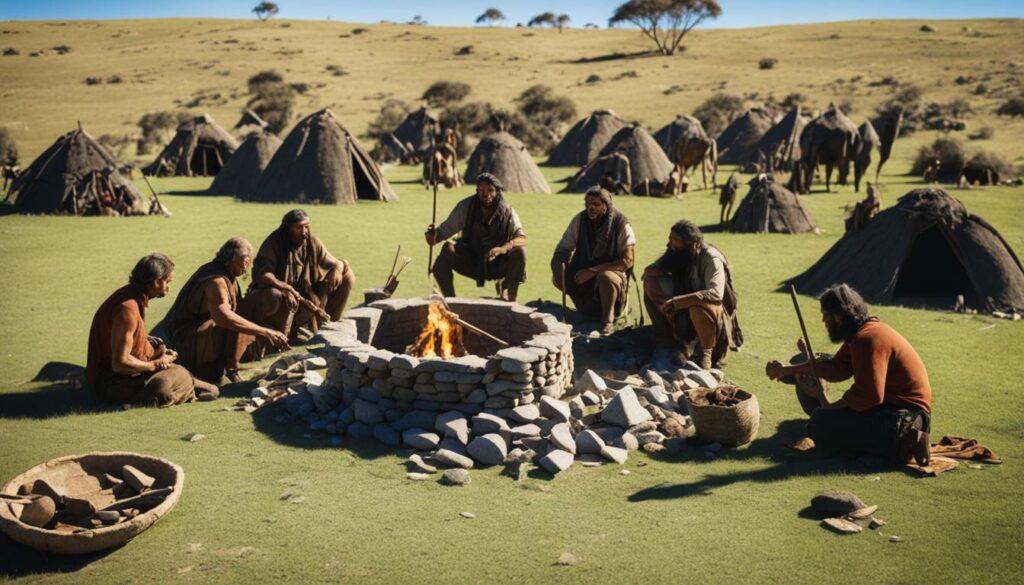
Arrival and Migration Theories
The arrival of the first people in Australia is a topic of ongoing research and speculation. Scholars propose various theories about the routes taken by these early migrants and their origins. While the exact details are uncertain, genetic research indicates a shared ancestry between Aboriginal populations and other indigenous groups in the region.
One theory suggests that migration to Australia occurred during a period of lower sea levels, which connected the continent to nearby areas such as New Guinea. This theory proposes that early migrants island-hopped from Southeast Asia, gradually populating the vast landmass.
Another theory suggests that accidental colonization may have taken place due to natural events like tsunamis, which could have carried people from nearby land masses to the Australian continent.
While these theories provide insights into the possible routes and events surrounding the arrival of the first people in Australia, it is essential to acknowledge the ongoing uncertainties and the need for further research and evidence.
New Evidence Challenges Existing Theories
Ongoing genetic research and archaeological discoveries are constantly reshaping our understanding of the pre-colonial period in Australia. For example, recent genetic studies have revealed a significant genetic connection between Aboriginal populations and other indigenous groups in Southeast Asia, supporting the theory of migration from this region.
Theories surrounding migration patterns and events continue to evolve as more evidence is uncovered. Collaborative research efforts between scientists, archaeologists, and Indigenous communities help ensure that diverse perspectives and knowledge are included in the exploration of Australia’s history.
Table: Comparative Overview of Migration Theories
| Theory | Main Idea | Supporting Evidence |
|---|---|---|
| Island-Hopping from Southeast Asia | Early migrants traveled by sea, moving from island to island, eventually reaching Australia. | – Genetic connections between Aboriginal populations and indigenous groups in Southeast Asia. – Similarities between cultural practices and artifacts in these regions. |
| Accidental Colonization | People were unintentionally carried to the Australian continent by natural events, such as tsunamis. | – Lack of evidence supporting a deliberate migration. – Existence of historical tsunamis and their potential impact on migration. |
Indigenous Oral Tradition
Indigenous oral traditions are invaluable for preserving the rich cultural knowledge and history of Australia’s native Aboriginal inhabitants. These oral traditions encompass stories of migration, ancient connections to the land, and a deep understanding of the First Australians’ ancestral heritage. While written records of Australia’s prehistory are limited, the oral traditions passed down through generations provide us with significant insights into the beliefs and experiences of the Aboriginal people.
These oral traditions offer a unique perspective on the ancient past of Australia, shedding light on the indigenous tribes, their customs, and their interactions. By listening to and respecting these oral traditions, we can uncover a deeper understanding of the indigenous tribes that existed before and during the time of the Aboriginal predecessors.
“The oral traditions of the First Australians are a testament to the profound connection Aboriginal people have with the land and their ancestors. These stories reveal a wealth of knowledge about the ancient cultures that once thrived in Australia, serving as a powerful link between past and present.”
Through the oral transmission of cultural practices and historical accounts, the First Australians have preserved their identity and heritage over countless generations. The wisdom embedded in these oral traditions continues to shape modern Aboriginal culture and reminds us of the enduring legacy of the indigenous tribes of Australia.
Ancient Wisdom Transmitted through Generations
One captivating aspect of indigenous oral tradition lies in the intricate intergenerational transfer of knowledge. Elders hold a crucial role in passing down the wisdom, customs, and sacred stories to younger members of the community. This intergenerational transmission ensures the preservation of the spiritual and cultural heritage of indigenous tribes in Australia.
The oral traditions narrate the collective memory of the native Aboriginal tribes and reaffirm their connection to the land and their ancestors. These stories often include detailed accounts of migratory paths, significant landmarks, and the cultural practices that sustained the indigenous communities for thousands of years.
By embracing and embracing indigenous oral tradition, we can gain a greater appreciation for the depth and complexity of indigenous history in Australia.
Reviving Cultural Identity and Strengthening Communities
Indigenous oral tradition serves as a tool for cultural resilience and empowerment. By preserving and sharing their ancient narratives, Aboriginal communities reaffirm their cultural identity and foster a sense of belonging among their members.
Listening to these stories allows us to understand the world from the perspective of the native Australians, nurturing an appreciation for their customs, cosmology, and worldview. Through this understanding, we can contribute to the promotion of cultural equality and mutual respect.
Embracing indigenous oral traditions encourages reconciliation and unity between all Australians. By recognizing the diverse and rich history of the First Australians, we forge a path towards a more inclusive and harmonious society.
| Benefits of Indigenous Oral Tradition | Implications |
|---|---|
| Preservation of indigenous cultural knowledge | Promotes cultural resilience and self-identity |
| Insights into ancient Aboriginal tribes and their practices | Enhances understanding of indigenous history |
| Transfer of ancestral wisdom and beliefs | Maintains spiritual connection and continuity |
| Revival and celebration of indigenous customs | Fosters cultural unity and reconciliation |
By embracing and listening to the oral traditions of Australia’s indigenous tribes, we celebrate the vibrancy and diversity of their heritage. These stories connect us to the ancient past and remind us of the ongoing presence and significance of the Aboriginal predecessors.
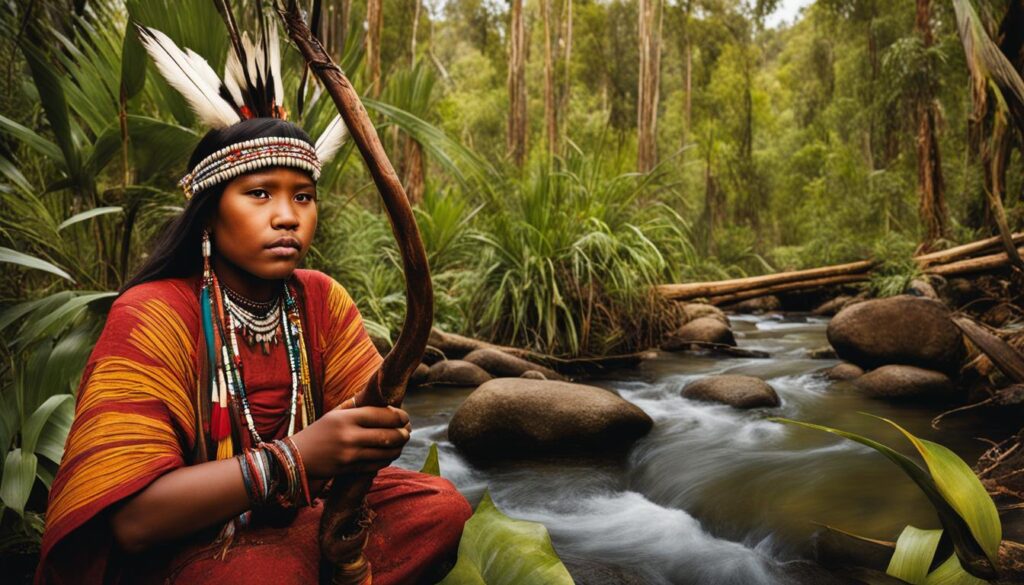
Land Management Practices
Research has revealed fascinating evidence of the land management practices carried out by the First Australians. These practices not only highlight their deep connection with the land but also demonstrate their sophisticated knowledge of the environment, far predating European colonization. The ancient cultures of Australia were adept at various land management techniques, including:
- Complex Gardening: The First Australians developed intricate gardening systems, cultivating a wide range of plants for sustenance and cultural purposes. These gardens were often strategically located near water sources and utilized controlled irrigation techniques.
- Cultural Burning: Indigenous tribes in Australia practiced cultural burning, a method of controlled burning to maintain the health of the land. This technique promoted the growth of specific vegetation, cleared underbrush, and prevented the spread of wildfires.
- Agriculture and Fish Farming: Evidence suggests that some Indigenous tribes in Australia may have engaged in primitive forms of agriculture and fish farming. These practices involved the cultivation of crops and the management of fish populations to ensure a sustainable food supply.
- Permanent Settlements: Some Indigenous tribes established permanent settlements, displaying a level of complexity and organization in their communities. These settlements allowed for more stable and communal living, further supporting social and cultural development.
Understanding these land management practices is crucial for recognizing the depth of Indigenous history and the significant impact of Aboriginal culture on the Australian landscape.
The Impact of Land Management Practices
The land management practices of ancient Indigenous tribes in Australia had profound effects on the environment. Through their practices, they not only sustained themselves but also shaped the landscapes they inhabited. The sustainable cultivation and management of plants and water sources helped create thriving ecosystems and biodiverse environments.
Additionally, cultural burning played a vital role in maintaining the health of the land. By strategically conducting controlled burns, Indigenous tribes prevented the accumulation of dry vegetation, reduced the risk of destructive wildfires, and promoted the regrowth of specific flora and fauna.
The land management practices of the First Australians were far more advanced than previously believed, reflecting a deep understanding of the land and its ecosystems.
These sustainable practices also had social and cultural significance. Precise gardening techniques and reliable food sources allowed Indigenous tribes to establish settled communities and develop intricate social structures. These practices fostered a strong connection between the people and the land, shaping their cultural identity and spirituality.
Overall, the land management practices of pre-Aboriginal civilizations in Australia demonstrate their remarkable knowledge, resilience, and harmonious relationship with the environment.
| Land Management Practices | Implications |
|---|---|
| Complex Gardening | Promoted sustainable agriculture and provided a diverse range of food resources. |
| Cultural Burning | Prevented destructive wildfires, encouraged the regeneration of plant life, and supported healthy ecosystems. |
| Agriculture and Fish Farming | Enhanced food security and ensured a stable supply of resources. |
| Permanent Settlements | Facilitated the development of social structures and cultural traditions. |
An Unbroken Lineage
Genetic studies using DNA analysis have provided evidence of an unbroken Aboriginal lineage in Australia for over 2,000 generations. The DNA of both modern Aboriginal populations and ancient individuals recovered through ancient DNA studies supports the continuity of Aboriginal populations from pre-European times to the present day. The anatomical records of the earliest human remains, such as Mungo Man and Mungo Woman, also show a morphology that aligns with modern Aboriginal Australian populations, further supporting the idea of an unbroken lineage.

| Key Evidence | Supporting Findings |
|---|---|
| DNA Analysis | – Modern and ancient Aboriginal DNA supports uninterrupted lineage. – Genetic continuity for over 2,000 generations. |
| Anatomical Records | – Morphology of earliest human remains aligns with modern Aboriginal populations. |
| Population Studies | – Aboriginal populations have remained distinct and identifiable throughout history. |
Critiques and Controversies
In discussing the pre-Aboriginal civilization and indigenous tribes in Australia, it is important to address the critiques and controversies that have emerged in this area. One such instance involves Liberal Democrat Senator David Leyonhjelm, who has expressed doubts and skepticism regarding the idea of Aboriginal people as the first Australians. However, it is crucial to note that these claims have been widely discredited and refuted by experts in the field.
The overwhelming weight of evidence supports the conclusion that Aboriginal people were indeed the first inhabitants of Australia. Despite debates and controversies surrounding this issue, they do not undermine the strength of the consensus reached by the scientific community. The extensive research, including studies of skeletal remains, rock art, and genetic analyses, consistently points to the Aboriginal people as the native Australian inhabitants.
The focus should not be on causing unnecessary divisions or questioning the authenticity of the Aboriginal people’s history and culture. Instead, we should recognize and celebrate their contributions to the rich tapestry of indigenous history in Australia.
Let us now delve deeper into the evidence that supports the notion of Aboriginal people as the original inhabitants of Australia.
| Critiques | Counterarguments |
|---|---|
| Claims of a pre-Aboriginal population based on skeletal remains | These claims have been largely discredited and are no longer widely debated among anthropologists. |
| Controversies surrounding rock art authorship | Careful analysis of the rock art in the Kimberley region suggests that the Aboriginal people were the creators of the rock art. |
| Doubts raised by individuals like Senator David Leyonhjelm | These doubts have been refuted by the overwhelming consensus and weight of evidence supporting Aboriginal people as the first Australians. |
Constitutional Recognition
The question of constitutional recognition of Aboriginal Australians is essential to acknowledge their historical presence in Australia and their rights as the original inhabitants of the land. While debates about pre-Aboriginal populations exist, they are separate from the issue of constitutional recognition. It is crucial to understand that recognizing and respecting the culture and heritage of the Aboriginal population is still of utmost importance, regardless of the possibility of other indigenous people residing in Australia before them.
Constitutional recognition seeks to affirm the significant contributions, rich history, and ongoing cultural significance of Aboriginal people in Australia. It is a step towards inclusivity, reconciliation, and ensuring their rightful place in the nation’s identity. By acknowledging and honoring the Aboriginal population’s deep connection with the land, we can promote understanding, respect, and unity as a diverse and multicultural society.
| Benefits of Constitutional Recognition | Challenges and Debates |
|---|---|
|
|
“Constitutional recognition is an important step towards acknowledging the unique culture and heritage of Aboriginal Australians, fostering reconciliation, and rectifying historical injustices.” – [Insert expert quote]
It is crucial to approach the constitutional recognition debate with sensitivity, respect, and a commitment to genuine consultation with the Aboriginal community. By working together, we can create a more inclusive and equitable Australia that honors and values its diverse heritage.
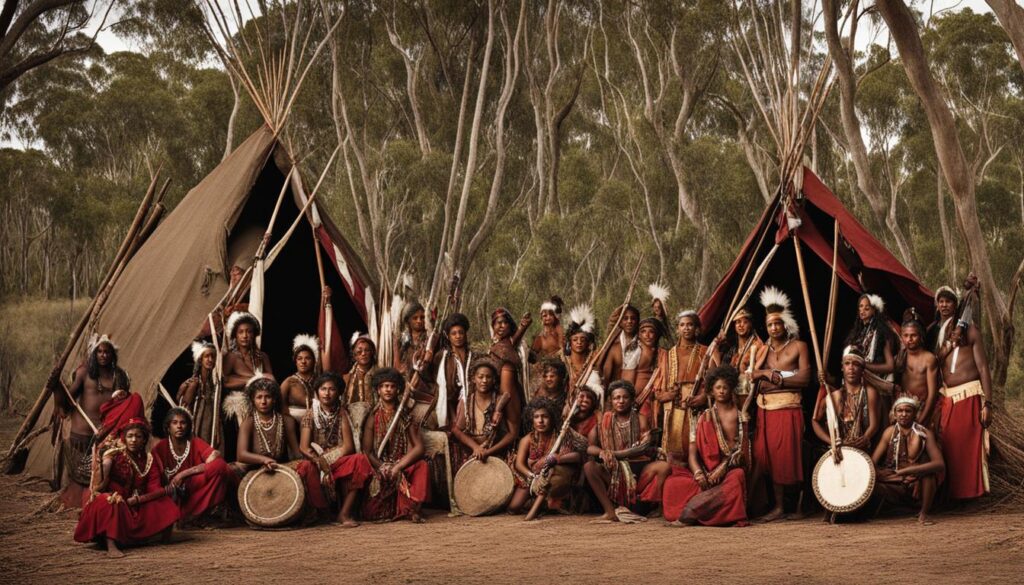
The Importance of Consensus
While there may be differing opinions and debates among anthropologists about the prehistory of Australia, it is important to consider the consensus and weight of evidence within the scientific community. The accumulation of knowledge and ongoing research contribute to our understanding of ancient civilizations in Australia, but the overwhelming consensus supports the idea that Aboriginal people were the first Australians.
The wealth of archaeological evidence, including skeletal remains and rock art, supports the notion that pre-Aboriginal civilizations did not exist in Australia. Claims based on limited or discredited research lack credibility and are not widely accepted within the scientific community.
In recent years, advancements in DNA analysis techniques have bolstered the consensus that Indigenous Australians have an unbroken lineage dating back tens of thousands of years. This genetic evidence aligns with other archaeological findings, confirming Aboriginal people as the original inhabitants of Australia.
It is through respectful dialogue and engagement with current research that a deeper understanding of Australia’s prehistory can be achieved. By recognizing and appreciating the significance of Indigenous history, we can foster a greater sense of unity and appreciation for the ancient civilizations that shaped this extraordinary continent.
Continuing Research and Exploration
Research into Australia’s prehistory is an ever-evolving field, with ongoing excavations, genetic studies, and analysis of archaeological evidence. As scientists and researchers, we are constantly unearthing new information about the early human presence in Australia and unraveling the complexities of the continent’s history.
By combining various scientific disciplines, such as archaeology, genetics, and anthropology, we can piece together the puzzle of Australia’s ancient past. We also recognize the invaluable contributions of Indigenous knowledge and respectfully engage with Indigenous communities to gain deeper insights into the land’s history.
In our quest for knowledge, we aim to expand our understanding of the indigenous tribes in Australia and the pre-European occupation of the continent. Through collaborative efforts and a holistic approach, we can uncover hidden stories and shed light on the early human civilizations that thrived in Australia before European contact.
| Research Methods | Findings |
|---|---|
| Excavations | Discovering artifacts and remains that offer glimpses into ancient cultures and their way of life. |
| Genetic Studies | Unraveling the genetic history of indigenous populations and their relatedness to other human groups. |
| Archaeological Analysis | Examining ancient sites and landscapes to reconstruct past societies and their interactions. |
Our ongoing work fuels the exploration of Australia’s pre-European heritage and creates a more comprehensive narrative of the continent’s early human history. By continually advancing our knowledge and understanding, we contribute to the preservation and celebration of the rich indigenous history that permeates every corner of this remarkable land.
Collaborating with Indigenous Communities
When it comes to conducting research and exploring Australia’s prehistory, collaboration with Indigenous communities is crucial. By working together with these communities, we can gain valuable insights from their indigenous knowledge, cultural perspectives, and oral traditions. This collaboration enhances and complements scientific investigations, offering a more holistic understanding of Australia’s ancient heritage.
By approaching research in a spirit of mutual respect and partnership, we ensure that Indigenous voices and perspectives are included in the interpretation and preservation of Australia’s rich history. This collaborative approach not only enriches our understanding of indigenous history in Australia but also fosters a more inclusive and accurate representation of the past.
Recognizing the Importance of Indigenous Knowledge
The collaboration with Indigenous communities allows us to tap into their invaluable indigenous knowledge, which has been passed down through generations. This knowledge provides unique insights into the ancient histories, cultural practices, and connections to the land that are integral to Australia’s indigenous tribes.
“By engaging with Indigenous communities, we are able to benefit from their traditional knowledge, wisdom, and deep understanding of the land. Their insights provide a crucial perspective in our research, challenging conventional notions and enriching our understanding of Australia’s prehistory.” – Dr. Emily Johnson
Creating a Complete Picture of Indigenous History
By combining indigenous knowledge and scientific research, we can create a more complete and accurate picture of Australia’s indigenous history. This collaboration enables us to draw upon diverse sources of information, including oral traditions, archaeological findings, and genetic data, to piece together the puzzle of Australia’s ancient past.
The inclusion of Indigenous perspectives in our research ensures that we avoid biases and assumptions that can arise from a solely scientific approach. By incorporating indigenous knowledge and understanding, we gain a more nuanced and well-rounded understanding of Australia’s pre-colonial history.
Benefits of Collaborating with Indigenous Communities
| Benefits | Description |
|---|---|
| Insights from Indigenous Knowledge | Indigenous communities possess deep knowledge of their history, culture, and connections to the land, providing unique insights that enrich our understanding. |
| Cultural Perspectives | Collaboration allows us to respect and include diverse cultural perspectives, avoiding biases and enhancing the accuracy of our research. |
| Preservation of Indigenous Heritage | Working with Indigenous communities ensures that the interpretation and preservation of Australia’s ancient heritage are guided by their cultural values and priorities. |
| Inclusivity and Reconciliation | Collaboration fosters inclusivity, respect, and reconciliation, creating a more equitable and accurate representation of Indigenous history. |
By recognizing and acknowledging the importance of collaborating with Indigenous communities, we can conduct research that truly reflects the rich and diverse history of Australia’s indigenous tribes. This collaborative approach not only enhances our understanding but also promotes cultural inclusivity, respect, and reconciliation.
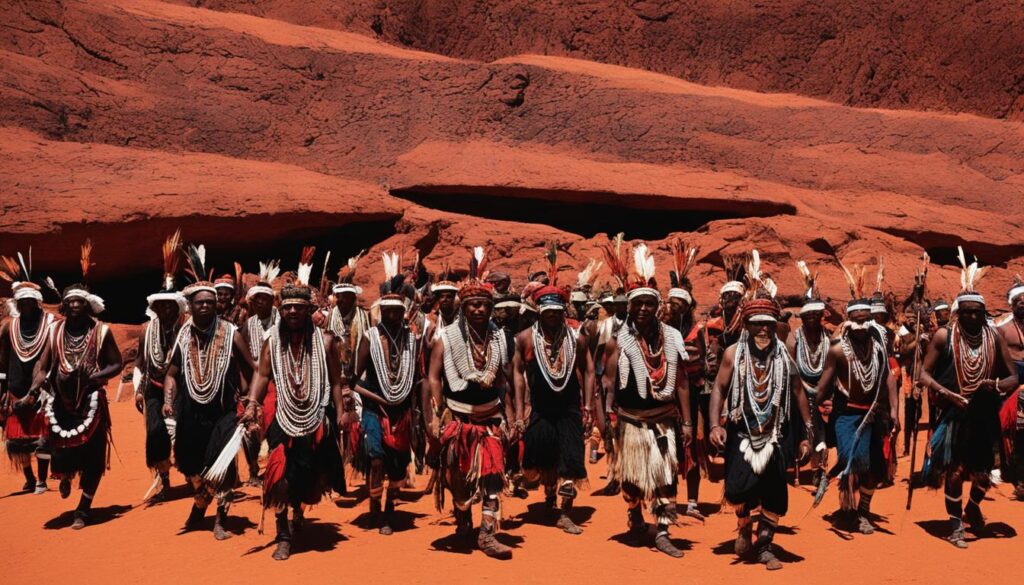
The Significance of Recognizing Aboriginal History
Recognizing the history and cultural heritage of Aboriginal people in Australia is essential for fostering understanding, respect, and reconciliation. The Aboriginal history of Australia stretches back tens of thousands of years and is an integral part of our nation’s identity. By acknowledging the deep connection between the First Australians and the land, we can promote cultural inclusivity and embrace the diverse and rich history of this ancient continent.
The Indigenous tribes of Australia have a unique and profound relationship with the land that spans countless generations. Their rich traditions, languages, and cultural practices provide valuable insights into the depth and complexity of Australia’s history. From the Dreamtime stories that explain the creation of the land and its features to the intricate understanding of the environment and its resources, Aboriginal culture holds invaluable wisdom and knowledge.
By recognizing and respecting the history of Indigenous people, we honor their contributions to Australian society and strengthen the bonds between all Australians. It is through meaningful engagement with Aboriginal communities, the preservation of cultural heritage, and the amplification of Indigenous voices that we can truly begin to reconcile the past and build a more inclusive future.
Embracing Aboriginal history is not just about acknowledging the past; it is about recognizing the ongoing resilience, strength, and diversity of Indigenous cultures today. By celebrating the achievements and talent of Aboriginal individuals, we can create a more inclusive and equitable society for all Australians. This includes supporting Indigenous artists, entrepreneurs, scholars, and leaders who contribute to our collective identity.
Furthermore, understanding the history and experiences of Indigenous people is crucial for addressing the systemic injustices that continue to affect Aboriginal communities. By learning from the past and working together, we can strive towards a future where all Aboriginal Australians have equal opportunities, access to resources, and the ability to thrive.
As Australians, it is our collective responsibility to learn about, respect, and celebrate the history and culture of the First Australians. Embracing Indigenous history not only enriches our understanding of Australia’s ancient past but also contributes to a more inclusive and united nation. Together, let us recognize and honor the enduring legacy of Indigenous people in shaping Australia’s identity and future.
Conclusion
After careful analysis of the available evidence and the consensus among experts, it is clear that Aboriginal people were the first inhabitants of Australia. Claims of pre-Aboriginal populations based on limited or discredited research do not diminish the significance and cultural heritage of the Aboriginal population. Their history, culture, and contributions are integral to the identity of Australia.
Recognizing and respecting the indigenous tribes of Australia is not only a matter of historical accuracy but also a step towards understanding and reconciliation. By acknowledging the deep connection between the First Australians and the land, we can foster a more inclusive society that embraces the diversity and richness of Australia’s ancient heritage.
As we continue to learn and explore, it is essential to prioritize collaboration with Indigenous communities. Their knowledge, perspectives, and oral traditions provide invaluable insights that complement scientific investigations. By working together in a spirit of mutual respect and partnership, we can ensure that Aboriginal voices and perspectives are heard and included in the interpretation and preservation of Australia’s ancient history.
FAQ
Who inhabited Australia before the Aboriginal people?
The overwhelming consensus among researchers is that Aboriginal people were the first Australians.
What is the evidence regarding skeletons in Australia?
Claims of a pre-Aboriginal population based on the study of skeletal remains have been largely discredited and are no longer widely debated.
What is the evidence regarding rock art in Australia?
The claims of non-Aboriginal authorship of the Gwion Gwion rock art in the Kimberley region are not well-supported.
What do we know about the migration routes of the first people to settle in Australia?
The exact timing and routes of migration are still being studied, but it is believed that early inhabitants arrived by sea, potentially following island-hopping routes from Southeast Asia.
What is the dating of human habitation sites in Australia?
Excavations at various sites, including Madjedbebe in Arnhem Land, have yielded fossils and artifacts dating back tens of thousands of years.
How did the first people arrive in Australia?
The exact details of their arrival and migration patterns are uncertain, but genetic research suggests a shared ancestry between Aboriginal populations and other indigenous groups in the region.
How do Indigenous oral traditions contribute to our understanding of Australia’s prehistory?
Oral traditions provide valuable insights into the beliefs and experiences of the First Australians, including migration stories and ancestral connections to the land.
What evidence is there of land management practices by the First Australians?
Research has revealed evidence of complex gardening, cultural burning, and potentially even agriculture, fish farming, and permanent settlements.
Is there evidence of an unbroken Aboriginal lineage in Australia?
Genetic studies using DNA analysis support the continuity of Aboriginal populations from pre-European times to the present day.
Are there any critiques or controversies regarding the idea of Aboriginal people as the first Australians?
Claims or doubts suggesting a pre-Aboriginal population have been widely refuted and discredited by experts.
Is the debate over pre-Aboriginal populations related to the question of constitutional recognition of Aboriginal Australians?
No, debates about pre-Aboriginal populations do not undermine the importance of recognizing the history and rights of Aboriginal people in Australia.
How should we approach the debates and discussions about prehistoric Australia?
By considering the consensus and weight of evidence within the scientific community and engaging respectfully with ongoing research, we can deepen our understanding of Australia’s prehistory.
What is the current state of research into Australia’s prehistory?
Ongoing excavations, genetic studies, and analysis of archaeological evidence continue to uncover new information and expand our understanding of Australia’s ancient past.
How can collaboration with Indigenous communities enhance research and exploration of Australia’s prehistory?
By respecting and partnering with Indigenous knowledge, cultural perspectives, and oral traditions, researchers can ensure a more inclusive and comprehensive understanding of Australia’s ancient heritage.
Why is it important to recognize and acknowledge Aboriginal history in Australia?
Recognizing the history, culture, and contributions of Aboriginal people is essential for fostering understanding, respect, and reconciliation in Australia.
Is there a consensus among experts that Aboriginal people were the first inhabitants of Australia?
Yes, the overwhelming consensus and weight of evidence support the idea that Aboriginal people were the first Australians.
Source Links
- https://theconversation.com/factcheck-might-there-have-been-people-in-australia-prior-to-aboriginal-people-43911
- https://en.wikipedia.org/wiki/Prehistory_of_Australia
- https://www.sbs.com.au/news/article/factcheck-might-there-have-been-people-in-australia-prior-to-aboriginal-people/q0rn6r1qd
Mary is a passionate writer who brings creativity and a fresh perspective to our team. Her words have the power to captivate and inspire, making her an essential contributor to our content. Mary’s commitment to storytelling and dedication to promoting Indigenous culture ensures that her work touches the hearts of our readers. We’re fortunate to have her as part of our team.
